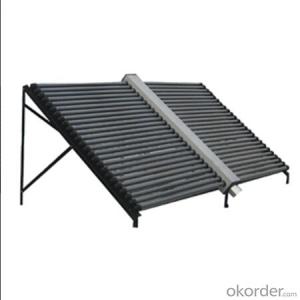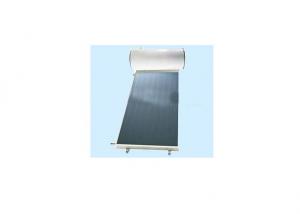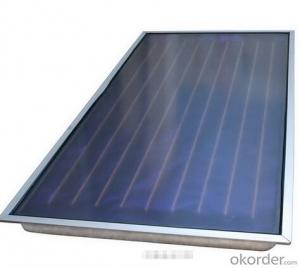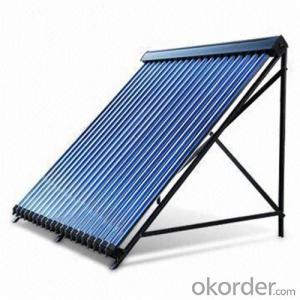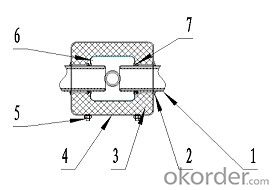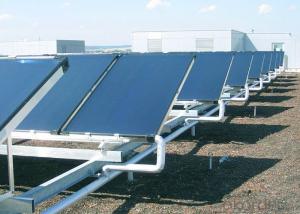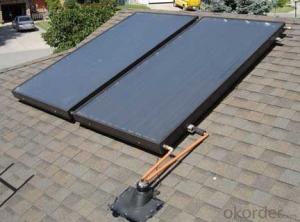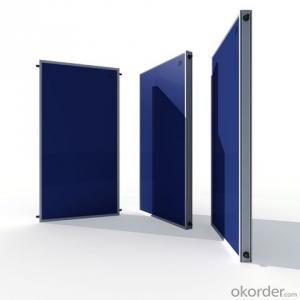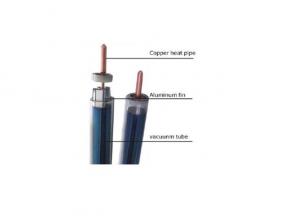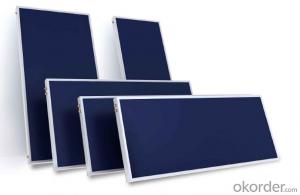Solar Project No-pressurized Solar Collector Model SC-V
- Loading Port:
- Shanghai
- Payment Terms:
- TT or LC
- Min Order Qty:
- 100 set
- Supply Capability:
- 500 set/month
OKorder Service Pledge
OKorder Financial Service
You Might Also Like
1. Structure of Solar Project No-pressurized Solar Collector Model SC-V
This kind of solar collector is designed for commercial buildings,Suitable for schools, dormitories, hotels, bath centers and other public constructions as well.
It is composed by the following parts:

1.vacuum tube 2.dustproof rubber 3.polyurethane insulation 4.casing 5.fixed bolt 6.inner tank 7. nozzle seal ring |
|
2. Main Features of Solar Project No-pressurized Solar Collector Model SC-V
Food grade SUS304 inner tank, corrosion resistant for long service life.
Unpressurized, suitable for natural circulation system,in large collector area,easy to assemble and install.
Polyurethane insulation, High pressure foaming process, small heat conductivity coefficient, not easy to loss heat.
3. Solar Project No-pressurized Solar Collector Model SC-V Images

4. Solar Project No-pressurized Solar Collector Model SC-V Specification
Model | SC-V-50-II | SC-V-60-II |
Tube Qty(pcs) | 50 | 60 |
Tube Pitch(MM) | 75 | 75 |
Tube Diameter/ Length(MM) | φ58/1800 | φ58/1800 |
Vacuum Tube Material | high borosilicate glass 3.3 | high borosilicate glass 3.3 |
Thickness of Inner Tube/OuterTube(MM) | 1.6/1.8 | 1.6/1.8 |
Inner tank Material / Thickness(MM) | SUS304/0.41 | SUS304/0.41 |
Joint Specification | 1″ | 1″ |
Insulation Material/ Thickness(MM)) | Polyurethane/40 | Polyurethane/40 |
Rated Pressure(MPa) | 0.003 | 0.003 |
Working Temperature ℃ | <100 | <100 |
Capacity(L) | 145 | 175 |
Collecting Area(㎡) | 4.8 | 5.8 |
Gross Area(㎡) | 7.72 | 8.24 |
Referral Traffic(L/min) | 5.76 | 6.96 |
Intercept Efficiency η0 | 0.62 | 0.62 |
Heat Loss Coefficient a | 3.0 | 3.0 |
Collector Net Weight(kg) | 12.5 | 129.5 |
Horizontal installation size | ||
Angle | 15° | 15° |
a (㎜) | 2060 | 2435 |
b (㎜) | 1974 | 2349 |
c (㎜) | 1860 | 2335 |
d (㎜) | 2023 | 2360 |
e (㎜) | 2200 | 2550 |
f (㎜) | 770 | 860 |
G (㎜) | 3715 | 3715 |
H (㎜) | 3560 | 3560 |
H/2 (㎜) | 1780 | 1780 |
5. FAQ
(1). Are the solar collectors noticeable on the roof?
If only the collector is mounted on the roof it should blend into the roof design quite well. Our solar collectors are very thin and can be flush mounted on a roof. From a distance they look somewhat like a skylight. You may have to check with your local council regarding building restrictions when installing your solar collector.
(2). Can the solar collectors be mounted on a flat surface?
Yes they may be mounted on a flat roof or on the ground by using a stainless steel Flat Roof Frame. The collector should be installed at a minimum of 20o angle to ensure optimal heat pipe operation.
(3). How do I protect my solar system during subzero temperatures?
If you have a system that is operating in areas with subzero temperatures, freeze protection must be implemented. The easiest means of preventing freezing is to use a controller with a low temperatures setting, so when the manifold temperature drops below a certain pre-set temperature (5oC/40oF), the pump will circulate, warming the collector with water from the bottom of the storage tank. The pump will not run continually, just periodically, the frequency of which will depend on the outside temperature. In extremely cold areas, a closed loop using a glycol/water mix may be appropriate.
- Q:Can solar collectors be used for heating car manufacturing plants?
- Yes, solar collectors can be used for heating car manufacturing plants. Solar thermal systems can provide heat for various industrial processes, including space heating, water heating, and even specific manufacturing processes. By harnessing solar energy, car manufacturing plants can reduce their reliance on fossil fuels and lower their carbon footprint.
- Q:Are solar collectors suitable for hospitals and healthcare facilities?
- Yes, solar collectors are suitable for hospitals and healthcare facilities. Solar collectors, also known as solar thermal systems, harness the energy from the sun to generate heat, which can be used for various purposes including water heating, space heating, and even powering cooling systems. Hospitals and healthcare facilities have significant energy requirements due to their round-the-clock operations, which include heating, cooling, and hot water needs. By incorporating solar collectors into their infrastructure, these facilities can significantly reduce their dependence on traditional energy sources, leading to cost savings and environmental benefits. Solar collectors are versatile and can be integrated into new constructions or retrofitted into existing buildings. They can be installed on rooftops, facades, or even as standalone structures. Furthermore, advancements in technology have made solar collectors more efficient and reliable, ensuring a consistent supply of renewable energy. The use of solar collectors in hospitals and healthcare facilities can also contribute to their sustainability goals and enhance their reputation as environmentally responsible institutions. By reducing carbon emissions, these facilities can mitigate their environmental impact and play a role in combating climate change. Additionally, solar collectors have the potential to provide a reliable energy source during power outages or emergencies. This is crucial for healthcare facilities, as uninterrupted power supply is essential for critical operations and patient care. In conclusion, solar collectors are indeed suitable for hospitals and healthcare facilities. They offer a sustainable and cost-effective solution to meet the high energy demands of these institutions while reducing their carbon footprint and promoting environmental stewardship.
- Q:Can solar collectors be used in areas with limited financial resources?
- Yes, solar collectors can be used in areas with limited financial resources. In fact, solar energy is often seen as a viable solution for such areas as it provides a clean and sustainable source of energy. Solar collectors can help reduce reliance on expensive and polluting fossil fuels, making energy more affordable and accessible for communities with limited financial means. Additionally, various financing models, such as microfinance initiatives and government subsidies, can help make solar collectors more affordable and feasible for these areas.
- Q:Can solar collectors be used in steel mills?
- Yes, solar collectors can be used in steel mills. Solar thermal collectors can be utilized to capture and convert solar energy into heat, which can then be used in various industrial processes, including steel production. This can help reduce the reliance on fossil fuels and decrease greenhouse gas emissions while providing a sustainable energy solution for steel mills.
- Q:Can solar collectors be used for heating bus stops?
- Yes, solar collectors can be used for heating bus stops. By capturing and converting sunlight into heat energy, solar collectors can provide a sustainable and eco-friendly solution for heating bus stops, ensuring passenger comfort even in colder climates.
- Q:Are solar collectors suitable for multi-unit buildings?
- Yes, solar collectors are suitable for multi-unit buildings. They can be installed on rooftops or facades of the building to harness solar energy and provide renewable energy to the entire building or individual units. This can help reduce electricity costs and dependence on fossil fuels, making it an environmentally friendly and cost-effective solution for multi-unit buildings.
- Q:How much space is required to install solar collectors?
- The space required to install solar collectors can vary depending on the type and size of the collectors, as well as the specific solar energy needs of a property. In general, rooftop solar collectors typically require a few hundred square feet of unshaded space, while ground-mounted systems may require larger areas of land. It is best to consult with a professional solar installer to determine the exact space requirements for a specific installation.
- Q:Can solar collectors be used for heating disaster relief areas?
- Yes, solar collectors can be used for heating disaster relief areas. By harnessing the energy from the sun, solar collectors can provide a sustainable and efficient source of heating, helping to warm up disaster relief areas and provide comfort to those affected by the disaster.
- Q:Can solar collectors be used for heating in tropical regions?
- Yes, solar collectors can definitely be used for heating in tropical regions. In fact, tropical regions are ideal for harnessing solar energy due to their abundant sunlight throughout the year. Solar collectors, such as solar water heaters or solar air heaters, can effectively capture the sun's rays and convert them into usable heat for various purposes including space heating, water heating, and even industrial processes. The high solar irradiance in tropical regions ensures a consistent and substantial amount of solar energy available for heating purposes. Additionally, the use of solar collectors in these regions can help reduce reliance on fossil fuels, decrease greenhouse gas emissions, and provide a sustainable and affordable alternative for heating needs.
- Q:Can solar collectors be used in power plants?
- Yes, solar collectors can be used in power plants. Solar collectors, such as photovoltaic panels or solar thermal systems, can be employed in power plants to harness the sun's energy and convert it into electricity.
1. Manufacturer Overview |
|
|---|---|
| Location | |
| Year Established | |
| Annual Output Value | |
| Main Markets | |
| Company Certifications | |
2. Manufacturer Certificates |
|
|---|---|
| a) Certification Name | |
| Range | |
| Reference | |
| Validity Period | |
3. Manufacturer Capability |
|
|---|---|
| a)Trade Capacity | |
| Nearest Port | |
| Export Percentage | |
| No.of Employees in Trade Department | |
| Language Spoken: | |
| b)Factory Information | |
| Factory Size: | |
| No. of Production Lines | |
| Contract Manufacturing | |
| Product Price Range | |
Send your message to us
Solar Project No-pressurized Solar Collector Model SC-V
- Loading Port:
- Shanghai
- Payment Terms:
- TT or LC
- Min Order Qty:
- 100 set
- Supply Capability:
- 500 set/month
OKorder Service Pledge
OKorder Financial Service
Similar products
New products
Hot products
Hot Searches
Related keywords
